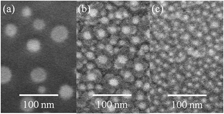No CrossRef data available.
Published online by Cambridge University Press: 01 January 2011

Small FePt grain size is one of the candidates for ultrahigh density magnetic recording material. We investigate increasing grain density of FePt grains fabricated on nanostructured substrates. One of them is nanodent-array (NDA) (period = 14 nm), and another is self-assembled silica nanoparticles (SASP) (period = 18 nm). In this paper, the influence of difference in nanostructured substrates on grain density Np is investigated in detail. FePt films were fabricated by sputtering and rapid thermal annealing (RTA) [Y. Itoh, T. Aoyagi, A. Tsukamoto, K. Nakagawa, A. Itoh, and T. Katayama, Jpn. J. Appl. Phys.43(12), 8040 (2004)]. FePt grains on those substrates show almost the same areal density; however, experimental results show that FePt grains on SASP has the largest Np while the initial film thicknesses are the same. Electron diffraction measurements indicate the existence of ordered FePt crystalline. The magnetic hysteresis loops are also shown.